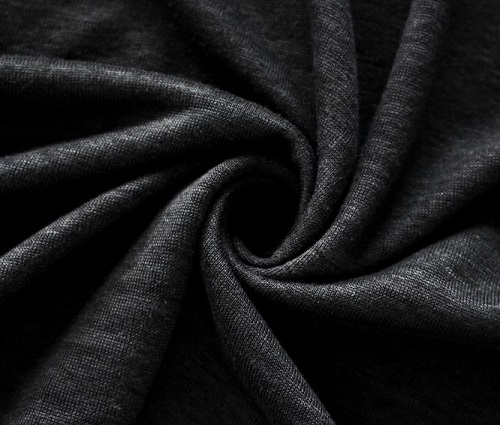0086-18057388688
Properties, Production, and Applications in Modern Textiles
Knit linen fabric occupies a unique position in the textile industry, merging the timeless qualities of linen with the flexibility and comfort of knit structures. Traditionally, linen has been associated with woven fabrics, prized for their strength, breathability, and natural luster. Advancements in knitting technology and yarn engineering have enabled linen to be used in knit constructions, expanding its utility in apparel, interior design, and technical textiles.
1. Raw Material Considerations
Origin of Linen Fiber
Linen is derived from the stalk of the flax plant (Linum usitatissimum). Its bast fibers are extracted through retting, scutching, and hackling processes, yielding long, lustrous fibers with a cellulose content of around 65–85%.
Linen fibers are:
- Long-stapled (up to 90 cm in length).
- High in crystallinity, providing durability and strength.
- Naturally hydrophilic, absorbing up to 20% of their weight in moisture without feeling damp.
Suitability for Knitting
Unlike cotton or wool, linen fibers are stiff and have limited elasticity.
This poses challenges when spinning and knitting:
- Spinning: Linen yarns tend to be coarse with less cohesion, making them prone to breakage in fine counts. Blending with cotton, viscose, or synthetic fibers often improves spinnability.
- Yarn Characteristics: Linen yarns have high tensile strength but low elongation, requiring adjustments in knitting machine settings to reduce stress and breakage.
2. Knitting Technologies for Linen
Flat Knitting vs. Circular Knitting
- Flat knitting machines: are often used for small-scale or high-end knit linen garments such as sweaters, cardigans, or fashion-forward tops.
- Circular knitting machines: are used for mass production of jersey, rib, and interlock structures. Fine-gauge production is difficult due to linen’s stiffness.
Common Knit Structures
- Single Jersey: Lightweight, suitable for breathable summer tops and t-shirts.
- Rib Knit: Enhances elasticity, compensating for linen’s lack of stretch.
- Interlock Knit: Provides stability and reduced curling, often used in higher-quality garments.
- Fancy Knits: Incorporating tuck stitches, mesh, or lace structures takes advantage of linen’s natural drape.
Blended Yarn Knitting
Knit linen fabrics often incorporate blends:
- Linen-Cotton: Improves softness and knitability.
- Linen-Viscose: Enhances drape and smoothness.
- Linen-Elastane: Adds stretch, particularly useful in fitted apparel.
3. Technical Characteristics of Knit Linen Fabric
Mechanical Properties
- Tensile Strength: Linen fibers are among the strongest natural fibers, ensuring durability.
- Abrasion Resistance: Moderate; knit structures may pill if blended with softer fibers.
- Elastic Recovery: Low, which can lead to bagging in knit garments.
Comfort Properties
- Moisture Management: Excellent wicking and breathability make knit linen fabrics ideal for hot climates.
- Thermal Conductivity: Linen dissipates heat rapidly, providing a cooling effect.
- Skin Sensation: Pure linen knits may feel coarse initially but soften with repeated washing.
Aesthetic and Functional Qualities
- Natural luster and unique slubs in linen yarn give knit fabrics a distinctive, textured look.
- Knitted structures enhance drape compared to woven linen.
- Prone to wrinkling, although the knit construction mitigates this compared to woven linen.
4. Production Challenges and Solutions
Yarn Breakage and Machine Stress
- Linen’s low elongation causes frequent yarn breakage in high-speed knitting. Solution: Use lower machine speeds, lubricated yarns, or blended yarns.
Curling and Distortion
- Single jersey knit linen fabrics tend to curl at edges. Solution: Stabilizing structures such as rib or interlock knits reduce curling.
Dimensional Stability
- Shrinkage during wet processing can distort knit fabrics. Solution: Pre-shrinking and mercerization processes improve dimensional stability.
Wrinkling
- Though less severe than in woven linen, wrinkles still appear. Solution: Blending with synthetic fibers or resin finishing reduces wrinkling.
5. Finishing and Post-Treatment
Wet Processing
- Scouring and Bleaching: Essential for removing impurities and achieving bright shades.
- Dyeing: Linen accepts dyes well but requires controlled conditions due to its low elasticity. Reactive dyes, VAT dyes, and natural dyes are commonly used.
Mechanical Finishes
- Calendering: Improves surface smoothness.
- Softening Treatments: Silicone or enzyme softeners reduce harshness.
- Compacting: Enhances dimensional stability in knits.
Functional Finishes
- Anti-wrinkle resins for crease resistance.
- Moisture management finishes for activewear.
- Antimicrobial finishes to complement linen’s natural resistance to bacteria.
6. Applications of Knit Linen Fabric
Apparel
- Casual Wear: T-shirts, polos, summer dresses, tunics.
- Luxury Knitwear: Sweaters, cardigans, high-fashion tops.
- Sportswear: When blended with elastane for stretch and comfort.
Home Textiles
- Cushion covers, throws, and lightweight blankets, valued for their natural look and breathability.
Technical Textiles
- Sustainable and biodegradable fabrics for eco-conscious markets.
- Knit linen composites for automotive and architectural applications when reinforced with resins.
7. Sustainability and Market Trends
- Sustainability: Linen is a low-input crop requiring minimal pesticides and water compared to cotton. Knit linen fabrics align with eco-friendly and circular fashion movements.
- Market Demand: Rising interest in natural, breathable fabrics for summer apparel is driving growth.
- Innovation: Development of fine-gauge linen yarns and blends is expanding applications beyond traditional summer wear.
Knit linen fabric represents a technical innovation that bridges the gap between tradition and modern textile engineering. While challenges such as low elasticity and machine adaptability remain, blending, finishing, and advanced knitting technologies have made it a viable choice for a wide range of applications. Its combination of breathability, sustainability, and aesthetic appeal ensures that knit linen will continue to play a vital role in the future of sustainable and functional textiles.
































